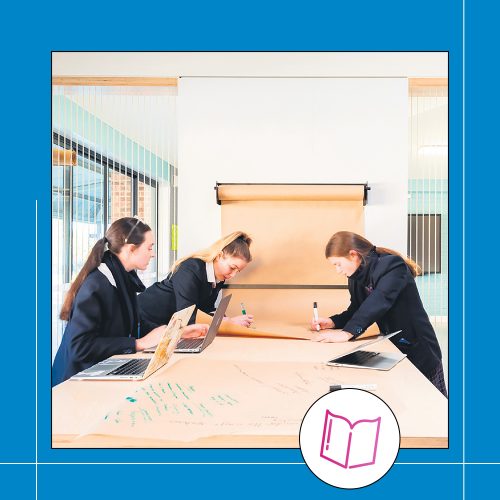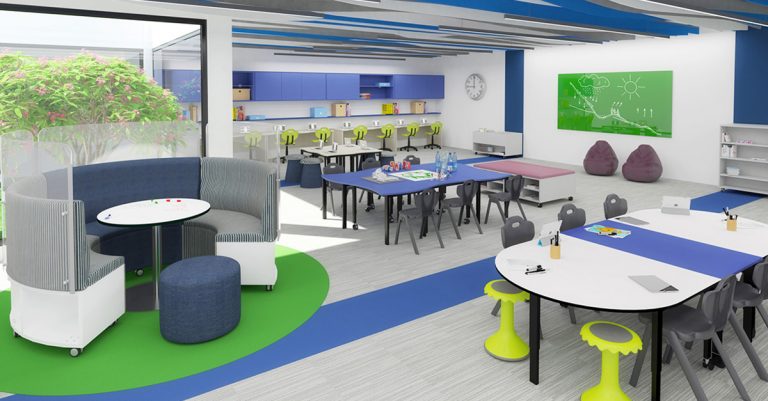The importance of the right furniture in a learning space can’t be underestimated. Australian students spend approximately 11,000 hours receiving school instruction between year one and year 12, so it is essential that the furniture they use support their learning.
Thanks to BFX’s involvement in a study led by the University of Melbourne, educators are now closer to understanding the relationship between furniture, students’ learning and engagement, and teaching practices so that these hours spent in the classroom are effective and engaging.
Educators are now closer to understanding the relationship between furniture, students’ learning and engagement.
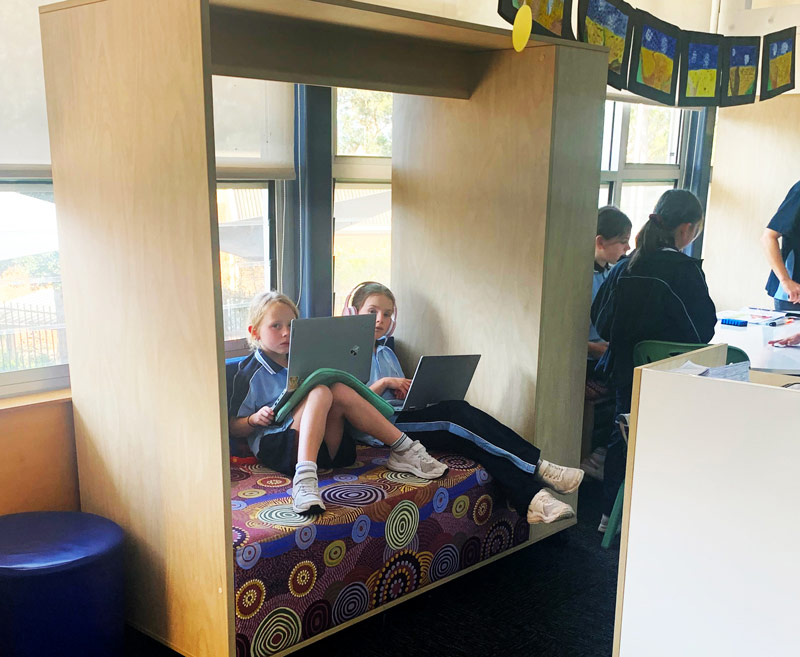
The Furniture for Engagement Study
In 2022, BFX collaborated with Dr Marian Mahat (Snr Research Fellow, The University of Melbourne) and Vivienne Awad (School Design Specialist, Sydney Catholic Schools) on the Furniture for Engagement study which focused on two Sydney Catholic schools. Other partners included LEaRN (the University of Melbourne’s Learning Environment Applied Research Network), Sydney Catholic Schools and Edith Cowan University.
The study was premised on the idea that furniture is an educational tool (Cornell, 2002; Harvey & Kenyon, 2013; Medd, 1984), which provides a physical connection between a child and their learning environment.
Furniture is an Educational Tool.
Traditional classroom furniture has favoured upright sitting positions (Mandal, 1985) and heavy, inflexible designs (Knight & Noyes, 1999). But according to Cornell (2002), furniture that is “more comfortable, adjustable, intuitive, reconfigurable, technology-capable, compressible, and attractive” (p. 35) could help teachers and students achieve their learning objectives.
While there is plenty of research regarding the impact of furniture on a child’s health and physical aspects, such as posture, there is limited research on whether furniture types and configurations can improve the learning and engagement of students. According to the final report, the few studies that do exist have shown that “flexibility in furniture arrangements can have a positive effect on learning outcomes (Gifford, 2002), lead to greater student satisfaction, autonomy (Attai et al., 2021) and agency (Morris & Imms, 2020) and can improve adaptive behaviours (Merrit, 2014; Schilling & Schwartz, 2004).” The Furniture for Engagement Study has taken this further to investigate the impact of furniture design by incorporating the perspective of the users – teachers and students.
The aim of the study
The aim was to investigate the impact of furniture and spatial settings on teaching and learning by investigating four main dependent variables: student learning, student engagement, teacher efficacy, and teacher mind frames. It is hoped that the information can positively influence the design of school furniture and teachers’ pedagogical practices to improve student’s learning and engagement.
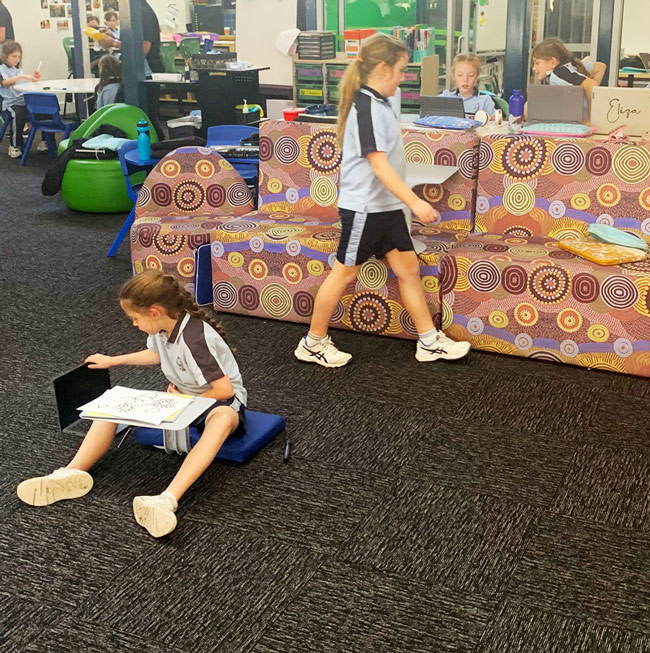
How the Furniture for Engagement study was conducted
Two primary schools (named Frangipani and Jasmine Primary Schools in the study) within the Sydney Catholic Schools diocese were involved as action case study sites. Both schools designed and implemented prototype learning environments with furniture provided by BFX Furniture.
Four teachers and 72 students from the two schools participated in both quantitative and qualitative data collection using two surveys that draw on several established models and surveys in the existing literature on this subject.
The first survey was used to determine teachers’ perceptions of their efficacy and mind frames, as well as their perceptions of their student’s learning and engagement while using the prototype space.
The second survey – the Learning Environments and Furniture Survey – used a photo-elicitation method. Both teachers and students took pictures of the furniture and learning space post-intervention, provided comments and answered questions on their perceptions of their learning spaces and new furniture on a four-point Likert scale of Strongly Agree to Strongly Disagree.
BFX’s role in the study
BFX’s General Manager of Product and Market Development, Connie Glover said that BFX were eager to collaborate with Sydney Catholic Schools and the University of Melbourne on a formal academic study to better understand how student and teachers use learning spaces to inform future design of learning spaces and furniture types for schools.
“We pride ourselves on being at the forefront of education furniture design and make it a priority to stay abreast of trends and anecdotal research from our clients into what really works for students. However, being able to draw on formal academic research that we’ve participated in will help us design furniture and learning spaces that are truly effective in combining aesthetics, function, comfort and learning engagement,” Connie explained.
We pride ourselves on being at the forefront of education furniture design and make it a priority to stay abreast of trends and anecdotal research from our clients into what really works for students.
BFX provided $40,000 worth of furniture to one school to furnish two of their classrooms. These furniture pieces included Zen Rests, Jelly Chairs, Cush Gippsland setting, Dynami Student Chair, Dynami Lab Stool and Plaza Hubs.
The BFX team were delighted to see photographic evidence of the students making themselves comfortable with various combinations of furniture: “It was great to see them interacting with each item and finding ways to use furniture to help them do their work,” said Connie.
The results: comfort, concentration, and noise control come out on top
Student perceptions
Quantitative data:
The data made it clear that the majority of students felt positively towards the new furniture. At Frangipani, 93% of students strongly agreed and agreed that they enjoyed learning 100% were more motivated to learn because of the new furniture.
While at Jasmine, 98% of students agreed or strongly agreed that they enjoyed learning more because of the furniture, a statistically significant 21% of students disagreed or strongly disagreed that they were motivated to learn because of the changes. That said, 94% of Jasmin students strongly agreed and agreed that they could now choose furniture that helped them learn best.
Over 86% of students in both schools agreed or strongly agreed that they liked their new furniture better than what was available in the previous classroom.
Qualitative results:
When analysed and coded student’s photos of the learning spaces (which primarily referred to spatial settings rather than furniture) against their comments, eleven themes emerged as factors that helped these students learn: comfort, concentrate, auditory, collaborate, choice, privacy, functionality, space, psychological, accessibility and vision. Although the results differed slightly between the two schools, when conflated, the top five reasons accounting for 75% of responses were:
- Comfort: they perceived that the nicer material, structural design and aesthetic factors of the furniture and the setting helped them feel mentally and physically relaxed.
“Because it’s flexible and comfortable.” (Frangipani student about the Plaza Hub) - Concentrate: they perceived improved focus from reduced distractions from peers or the surrounding environment, usually in individual or small settings.
“Because it makes me feel comfortable and makes me more focused.” (Frangipani student about the Jelly chairs) - Auditory: they perceived reduced noise levels and valued having a quiet place for learning.
“It feels calm and relaxing and it’s like the noise is blocked out.” (Jasmine student)
- Collaborate: they felt supported to work collaboratively with their peers with furniture and a setting that encouraged closer proximity and social interaction.
“I like this learning space because I feel like I can share my ideas in a small group.” (Jasmine student)
- Choice: they perceived they could better move around and choose how, where and with whom they studied.
“I like these spaces because I can work in a group on the whiteboard table, and I can focus on the single couch table tray seat.” (Jasmine student).
Teacher perceptions
Quantitative results
The same questions were asked before and after implementation of the new furniture and space design. Survey results from a teacher at Frangipani showed that their perceptions of their mind frame, student learning and student engagement improved after the new furniture was introduced, but not their efficacy.
Student learning and student engagement improved after the new furniture was introduced.
At Jasmine, both teachers perceived an improvement in mind frames, efficacy and student engagement in the prototype environment, however one teacher’s perception of student learning remained unchanged.
Qualitative results
While the published report focusses primarily on student perceptions, additional open-ended questions for teachers indicated that the theme of choice was just as important to teachers and students in terms of being able to choose how to group students (or not) and control which furniture works best for each task.
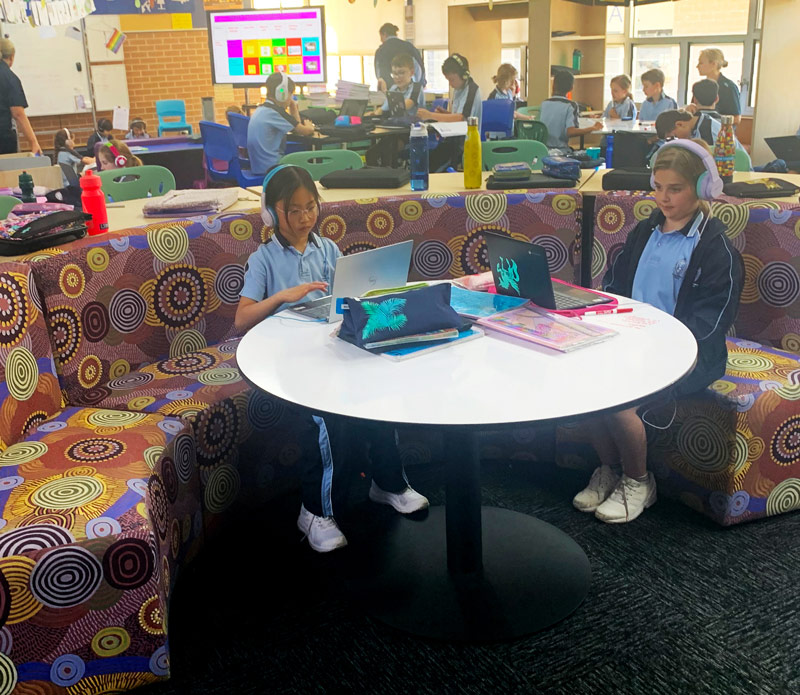
Conclusion
This study has shown the impact and value of thoughtful furniture and design choices in educational settings in allowing students to easily transition between activities, accomplish their learning goals, collaborate with others and study comfortably.
Having furniture and learning spaces that meets student’s needs for comfort, concentration, auditory control and collaboration does improve how students perceive their levels of enjoyment, motivation and autonomy in comparison to traditional furniture. However, choice plays a significant role, too. As stated in the final report: “For students, choice afforded them the agency to be part of the decision-making process, with whom and where they might learn best. Furniture that afforded choice can adapt to the evolving nature of teaching and learning, and consequently deliver the best possible experience for both students and teachers.”
The results and feedback from this report will guide BFX regarding our new furniture designs and the enhancement of our current products to benefit schools across Australia. The study also clearly demonstrated to BFX how Sydney Catholic Schools would like to furnish new and refurbished learning spaces which will make it easier to replicate successful settings in our renders and presentations.
We encourage all educators who are planning a new building or refurbishment to read the study to help them determine classroom designs and furniture choices that will deliver great learning experiences now and as pedagogical approaches change in the future.
References:
- Attai, S. L., Reyes, J. C., Davis, J. L., York, J., Ranney, K., & Hyde, T. W. (2021). Investigating the impact of flexible furniture in the elementary classroom. Learning Environments Research, 24(2), 153-167.
- Cornell, P. (2002). The impact of changes in teaching and learning on furniture and the learning environment. New directions for teaching and learning, 92, 33-42.
- Gifford, R. (2002). Environmental Psychology: Principles and Practice. Optimal Books
- Knight, G., & Noyes, J. A. N. (1999). Children’s behaviour and the design of school furniture. Ergonomics, 42(5), 747-760.
- Mandal, A. C. (1985). The Seated Man. Dafnia Publications
- Medd, D. (1984). An attitude to school design in retrospect: transcript of an address given at the open plan primary school conference at East Hampstead park. National Association for Primary Education.
- Morris, J. E. & Imms, W. (2020). Plans to pedagogy activity report 2019: What impact does ‘innovative’ furniture have on student engagement and teacher practices? Edith Cowan University.
- Merritt, J. M. (2014). Alternative seating for young children: Effects on learning. American Journal of Contemporary Research, 4(1), 12-18.
- Schilling, D. L. & Schwartz, I. S. (2004). Alternative seating for young children with autism spectrum disorder: Effects on classroom behaviors. Journal of Autism Developmental Disorders, 34(4), 423-432.


